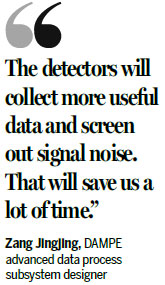Wukong sharpens its eyes for dark matter
Scientists have begun calibrating China's first dark matter probe in order to produce more accurate data, more than a month after the detector started to search for signals of the invisible material. The Dark Matter Particle Explorer Satellite, dubbed Wukong after the Monkey King character from the Chinese classic legend Journey to the West, was launched on Dec 17.
Like the Monkey King, who can see through objects with his sharp eyes, the satellite has the most sensitive and accurate detectors designed for dark matter.
Dark matter does not emit light or reflect electromagnetic radiation, but its existence can be inferred from its effects of measurements such as gravity and mass. It is one of the big mysteries of modern science. Exploration of dark matter could give scientists a clearer understanding of the past and future of galaxies and the universe.

Chang Jin, DAMPE chief scientist and deputy director of the Purple Mountain Observatory, said Wukong has already collected more than 100 million high-energy particles, including protons, alpha and cosmic-ray particles and nuclides. Scientists will look for high-energy electrons and gamma rays among them, which could be the residue of dark matter's annihilation or decay.
"Now the payload looks perfect, but it's not enough. If the calibration goes well, the signs we seek will pop out from the data," Chang said.
The payload has four major parts - a plastic scintillator array detector, a silicon array detector, a BGO calorimeter and a neutron detector - together comprising about 76,000 minor detectors. DAMPE scientific application chief designer Wu Jian said the payload was designed with very high accuracy, but colliding with cosmic rays will change the detectors' performance, so they need constant calibration.
Wukong is sending back about 20 GB of data a day. DAMPE advanced data process subsystem designer Zang Jingjing said all the data will be analyzed by a special computer equipped with 128 10-core CPUs.
"After calibration, the detectors will collect more useful data and screen out signal noise. That will save us a lot of time," Zang said.


















